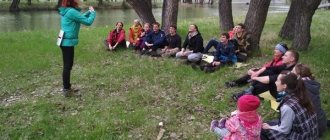Fun outdoor games for children in autumn
Fun outdoor games for children in autumn
1. In search of treasure. Take some kind of toy, sweets, etc. as a “treasure”. It's best to wrap it in foil. Show the sealed “treasure” to the children and ask them to close their eyes. Hide the “treasure” in a tree, behind a stump, swing, bench or somewhere else. Let the children go on a search. Whoever finds the “treasure” first wins.
2. Find a match. The leader distributes multi-colored circles or flags to all children (a pair of each item). At the leader’s signal, the children run, and when they hear a clap or the sound of a whistle, everyone must find a pair based on the color of the circle or flag and hold hands. An odd number of children can also take part in the game, then one will be left without a pair and will leave the game.
3. Reviving objects. This game is especially suitable for little ones. At home, cut out funny eyes from paper and take a piece of plasticine and go for a walk with the children. Let the children choose which objects they want to revive - flowers, trees, carousels... You can even arrange a competition between the children to see who can “revive” the objects the fastest. This develops children's imagination well.
4. Ring. Children sit on a bench or stand in a row. The leader takes a ring or some other small object and pretends to place this ring in the palms of each of the players. Then he says: “Ring, go out onto the porch!” and the one who really has the ring left in his palms tries to quickly jump out, and the other children try to prevent him from doing this. If the player manages to jump out, then he takes the place of the leader.
5. Find a plant. The children turn away, and the leader picks a leaf or any plant. The children’s task is to find the same one as quickly as possible. Whoever is first becomes the leader.
6. In the sandbox. We take some object, ask the children to turn away, and bury this little thing in the sandbox. Children must dig with shovels and find the buried object. (It’s very good to play this game on the beach. You just need to outline the area for searching).
7. Balloon tennis. Take badminton or tennis rackets. Inflate a balloon and use it instead of a tennis ball or shuttlecock. The balloon flies for a long time, and the child has time to think a little about where to run and hit the ball.
8. Winding the rope. Only two people can play this game. If there are more people willing, then you can play alternately with the winner, and the rest are fans. Take two identical branches or sticks and a longer rope (3 meters or more). We tie a branch or stick to each end of the rope. In the middle of this rope we tie a flag or make a knot. Each participant takes a stick and moves away so that the rope itself is well stretched. So, at a signal, the children begin to wind the rope around their stick. Whoever reaches the knot or flag the fastest is the winner!
9. Crow. One child is blindfolded and stands with his back to the children. Each player must approach the leader and place his hand on his shoulder. The driver says: “Caw, crow!” The player croaks, and the driver guesses the name of the one who croaked. If he guesses correctly, he changes places with the player.
10. Rain and sunshine. We draw a circle on the asphalt and ask the children to stand in it. When the presenter says “Sunshine,” the children leave the circle, run, and jump. And when they hear the word “Rain,” the children should form a circle as quickly as possible. Whoever is last loses.
11. Snake. Children join hands, and then a whole “chain” is built. The presenter takes the last one by the hand and leads this “snake”, making various unexpected turns. The kids must hold on tightly so as not to break the “chain.” If the children are quite old, then you can run like a snake.
12. “Deaf telephone.” Children line up. The first in the row whispers a word into the ear of his neighbor - he repeats this word to the other in a whisper, and so on, the last one names the word he heard. Usually the named word only causes laughter.
13. Repeater. Children stand in a circle, the first player shows some movement (for example, clapping), the next one repeats everything and adds another movement. So everyone must repeat all the movements shown in front of him and add his own. Whoever messes up is out of the game.
14. Edible - inedible. For this game, take a ball. Have the children stand in a row or sit on a bench. The driver begins to throw the ball to each player, naming an edible or inedible object. If the named item can be eaten, the children catch the ball, if not, they throw it back to the driver.
15. Drive more quietly. Children stand on one side of the “road”, and the leader stands on the other, turning his back to everyone. The presenter says: “The slower you go, the further you will go.” - the children begin to run, trying to reach the finish line as early as possible. After a few seconds, the presenter says: “Stop!” – the children stop running and freeze. The presenter turns around, and if he sees any movement of any player, he is eliminated from the game. The winner is the one who runs to the finish line first.
16. Hot potatoes. Children stand in a circle. The driver gives a signal or turns on music (you can use music from your phone). Children begin to throw the ball to each other, trying to get rid of it as quickly as possible. When the driver gives a signal or turns off the music, the one who still has the ball in his hands is eliminated from the game. When 1 player remains, the game ends and he becomes the winner.
17. Fishermen and fish. Two children are chosen as fishermen, and the rest are fish. The children begin to dance around the fishermen and sing a song: Fish live in the water, There is no beak, but they peck. If they have wings, they don't fly, but they don't have legs, but they walk. They don’t make nests, but they take out the babies. The “fishermen” join hands and quickly catch all the scattering “fish”. The “fish” that come across already become “fishermen”. Now these “fishermen” join hands and begin to catch other children. So the “Network” becomes even larger.
18. Simon speaks. The presenter must say the words: “Simon says” and then say what all the children should do. If the words: “Simon says” do not sound, then the command should not be executed. And the children answer: “Simon didn’t say that.” For example, the presenter says: “Simon says - run!” Children are running. Anyone who begins to carry out any command from the leader, without saying “Simon says,” misses a turn or leaves the game.
1. In search of treasure. Take some kind of toy, sweets, etc. as a “treasure”. It's best to wrap it in foil. Show the sealed “treasure” to the children and ask them to close their eyes. Hide the “treasure” in a tree, behind a stump, swing, bench or somewhere else. Let the children go on a search. Whoever finds the “treasure” first wins.
2. Find a match. The leader distributes multi-colored circles or flags to all children (a pair of each item). At the leader’s signal, the children run, and when they hear a clap or the sound of a whistle, everyone must find a pair based on the color of the circle or flag and hold hands. An odd number of children can also take part in the game, then one will be left without a pair and will leave the game.
3. Reviving objects. This game is especially suitable for little ones. At home, cut out funny eyes from paper and take a piece of plasticine and go for a walk with the children. Let the children choose which objects they want to revive - flowers, trees, carousels... You can even arrange a competition between the children to see who can “revive” the objects the fastest. This develops children's imagination well.
4. Ring. Children sit on a bench or stand in a row. The leader takes a ring or some other small object and pretends to place this ring in the palms of each of the players. Then he says: “Ring, go out onto the porch!” and the one who really has the ring left in his palms tries to quickly jump out, and the other children try to prevent him from doing this. If the player manages to jump out, then he takes the place of the leader.
5. Find a plant. The children turn away, and the leader picks a leaf or any plant. The children’s task is to find the same one as quickly as possible. Whoever is first becomes the leader.
6. In the sandbox. We take some object, ask the children to turn away, and bury this little thing in the sandbox. Children must dig with shovels and find the buried object. (It’s very good to play this game on the beach. You just need to outline the area for searching).
7. Balloon tennis. Take badminton or tennis rackets. Inflate a balloon and use it instead of a tennis ball or shuttlecock. The balloon flies for a long time, and the child has time to think a little about where to run and hit the ball.
8. Winding the rope. Only two people can play this game. If there are more people willing, then you can play alternately with the winner, and the rest are fans. Take two identical branches or sticks and a longer rope (3 meters or more). We tie a branch or stick to each end of the rope. In the middle of this rope we tie a flag or make a knot. Each participant takes a stick and moves away so that the rope itself is well stretched. So, at a signal, the children begin to wind the rope around their stick. Whoever reaches the knot or flag the fastest is the winner!
9. Crow. One child is blindfolded and stands with his back to the children. Each player must approach the leader and place his hand on his shoulder. The driver says: “Caw, crow!” The player croaks, and the driver guesses the name of the one who croaked. If he guesses correctly, he changes places with the player.
10. Rain and sunshine. We draw a circle on the asphalt and ask the children to stand in it. When the presenter says “Sunshine,” the children leave the circle, run, and jump. And when they hear the word “Rain,” the children should form a circle as quickly as possible. Whoever is last loses.
11. Snake. Children join hands, and then a whole “chain” is built. The presenter takes the last one by the hand and leads this “snake”, making various unexpected turns. The kids must hold on tightly so as not to break the “chain.” If the children are quite old, then you can run like a snake.
12. “Deaf telephone.” Children line up. The first in the row whispers a word into the ear of his neighbor - he repeats this word to the other in a whisper, and so on, the last one names the word he heard. Usually the named word only causes laughter.
13. Repeater. Children stand in a circle, the first player shows some movement (for example, clapping), the next one repeats everything and adds another movement. So everyone must repeat all the movements shown in front of him and add his own. Whoever messes up is out of the game.
14. Edible - inedible. For this game, take a ball. Have the children stand in a row or sit on a bench. The driver begins to throw the ball to each player, naming an edible or inedible object. If the named item can be eaten, the children catch the ball, if not, they throw it back to the driver.
15. Drive more quietly. Children stand on one side of the “road”, and the leader stands on the other, turning his back to everyone. The presenter says: “The slower you go, the further you will go.” - the children begin to run, trying to reach the finish line as early as possible. After a few seconds, the presenter says: “Stop!” – the children stop running and freeze. The presenter turns around, and if he sees any movement of any player, he is eliminated from the game. The winner is the one who runs to the finish line first.
16. Hot potatoes. Children stand in a circle. The driver gives a signal or turns on music (you can use music from your phone). Children begin to throw the ball to each other, trying to get rid of it as quickly as possible. When the driver gives a signal or turns off the music, the one who still has the ball in his hands is eliminated from the game. When 1 player remains, the game ends and he becomes the winner.
17. Fishermen and fish. Two children are chosen as fishermen, and the rest are fish. The children begin to dance around the fishermen and sing a song: Fish live in the water, There is no beak, but they peck. If they have wings, they don't fly, but they don't have legs, but they walk. They don’t make nests, but they take out the babies. The “fishermen” join hands and quickly catch all the scattering “fish”. The “fish” that come across already become “fishermen”. Now these “fishermen” join hands and begin to catch other children. So the “Network” becomes even larger.
18. Simon speaks. The presenter must say the words: “Simon says” and then say what all the children should do. If the words: “Simon says” do not sound, then the command should not be executed. And the children answer: “Simon didn’t say that.” For example, the presenter says: “Simon says - run!” Children are running. Anyone who begins to carry out any command from the leader, without saying “Simon says,” misses a turn or leaves the game.
Tips for parents
Children playing together with their parents benefits both. Children experience joy and bright emotions, and adults can get to know their child better and become closer to him. This is important in order to make childhood unforgettable and interesting for the child. Therefore, do not be lazy to play with him, do not be afraid to seem frivolous and funny, be a friend to him.
The games discussed in the article can be played both in the yard of the house and in a preschool or summer camp.
If you liked the article, please share a link to it
Ideas for snowy weather
It is adults who are afraid of the cold, but for children, snow and frost are excellent weather for sledding, playing snowballs and making snowmen. In winter, you can come up with other entertainment.
King of the Hill
A small snow-covered slide and 6-8 people are all you need for this game. Team members begin to climb the hill, trying to overtake others. The one who was the first to climb to the top declares himself king of the mountain. Now the king has a new task - to maintain power by pitting rivals against each other.
Important: in the game you cannot push your opponents with your feet or show excessive aggression. It is advisable to have an adult monitor safety.
Snow shooting range
Throwing snowballs at each other, although fun, is dangerous. But if you draw a target on the wall and throw snowballs at it, no one will get hurt.
Draw a line in the snow where you need to make the throw, agree on how many points are awarded for hitting the bull's eye, and start fighting for the title of the most accurate shooter. The target can be drawn directly on the snow - try using water tinted with food coloring for this.
Tip: a shooting range can be organized in the fall, and use acorns or chestnuts instead of shells.
Snow pictures
Snow sticks perfectly to a wall, tree or fence and serves as an excellent material for creating entire paintings. The snow base is well complemented by twigs, pebbles, and berries: these techniques are familiar to everyone who has made snowmen.
Of course, in the spring the creations will disappear without a trace, but the time will come for drawing with chalk on the asphalt.









